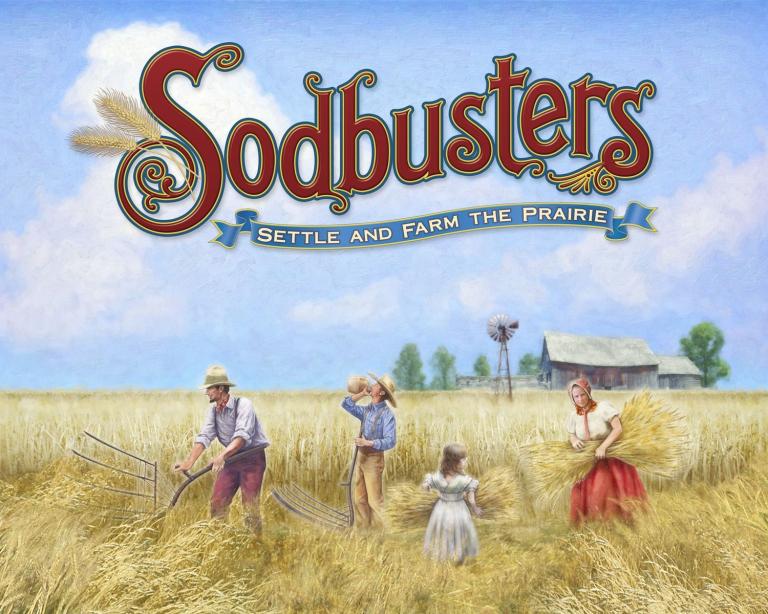Sodbusters

Sodbusters
The thematic setting of the game is the North American prairie as it was first being settled in the late 1800's and early 1900's.
The object of the game is to build the most profitable farming operation. Each player starts with a cash loan and one of 57 available sections of land, and may buy more land on any turn. On each section of land, players may plant one of four crops or raise one of four kinds of livestock.
Each turn represents one of the four seasons. The game consists of 20 turns (five "years" or full crop cycles). Each turn or season is divided into 3 phases which are played simultaneously by all players. In the "Purchase" phase players may buy land and animals and (if in season) plant crops. The "Event" phase consists of drawing cards which introduce events or conditions which may or may not affect players. For example, when a Tornado or Oil Strike event is drawn, a die roll mechanism is used to select specific land sections which are affected. In the "Harvest" phase, players sell any mature crops or livestock at the market price listed on a master Harvest card drawn for that turn.
Players may pay off their initial loan at any time. The amount due (representing combined principal and interest) grows substantially each "year". After the final turn, the player with the most cash left after paying off the loan is the winner. Land and other permanent farming assets may not be sold to raise cash. This simulates the practice of the first generation retiring and handing the farming operation intact to the next generation.
The game mechanism allows for solitaire play, in which the object would be to record a personal best amount of cash at the end. The primary effect of introducing more players is the competition for prime farmland. The length of play is not affected greatly since each phase is played simultaneously by all. Game testing showed a substantial increase in speed of play after players had played 2-3 times. For a game in which most or all players are novices, allow 4 hours.
Although the game includes a substantial amount of luck (farmers cannot control weather or market prices) it cannot be won by luck alone. Successful players will learn how to best farm different types of land (it is not all equal), manage risk, and select appropriate crop or livestock strategies (the various options include a wide range of risk/reward trade offs).
The game could be used in an educational setting either to illustrate the historical settling of the prairies or to demonstrate the basics of investing in any context (managing risk, balancing a portfolio, using leverage, etc.)
The object of the game is to build the most profitable farming operation. Each player starts with a cash loan and one of 57 available sections of land, and may buy more land on any turn. On each section of land, players may plant one of four crops or raise one of four kinds of livestock.
Each turn represents one of the four seasons. The game consists of 20 turns (five "years" or full crop cycles). Each turn or season is divided into 3 phases which are played simultaneously by all players. In the "Purchase" phase players may buy land and animals and (if in season) plant crops. The "Event" phase consists of drawing cards which introduce events or conditions which may or may not affect players. For example, when a Tornado or Oil Strike event is drawn, a die roll mechanism is used to select specific land sections which are affected. In the "Harvest" phase, players sell any mature crops or livestock at the market price listed on a master Harvest card drawn for that turn.
Players may pay off their initial loan at any time. The amount due (representing combined principal and interest) grows substantially each "year". After the final turn, the player with the most cash left after paying off the loan is the winner. Land and other permanent farming assets may not be sold to raise cash. This simulates the practice of the first generation retiring and handing the farming operation intact to the next generation.
The game mechanism allows for solitaire play, in which the object would be to record a personal best amount of cash at the end. The primary effect of introducing more players is the competition for prime farmland. The length of play is not affected greatly since each phase is played simultaneously by all. Game testing showed a substantial increase in speed of play after players had played 2-3 times. For a game in which most or all players are novices, allow 4 hours.
Although the game includes a substantial amount of luck (farmers cannot control weather or market prices) it cannot be won by luck alone. Successful players will learn how to best farm different types of land (it is not all equal), manage risk, and select appropriate crop or livestock strategies (the various options include a wide range of risk/reward trade offs).
The game could be used in an educational setting either to illustrate the historical settling of the prairies or to demonstrate the basics of investing in any context (managing risk, balancing a portfolio, using leverage, etc.)
Player Count
1
-
6
Playing Time
120
Age
10
Year Released
2008
Newest Review
Remote video URL